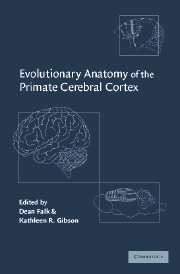Book contents
- Frontmatter
- Contents
- List of contributors
- Preface
- Prologue: Size matters and function counts
- Part I The evolution of brain size
- Introduction to Part I
- 1 Encephalization and its developmental structure: how many ways can a brain get big?
- 2 Neocortical expansion and elaboration during primate evolution: a view from neuroembryology
- 3 In defense of the Expensive Tissue Hypothesis
- 4 Bigger is better: primate brain size in relationship to cognition
- 5 The evolution of sex differences in primate brains
- 6 Brain evolution in hominids: are we at the end of the road?
- Part II Neurological substrates of species-specific adaptations
- Epilogue: The study of primate brain evolution: where do we go from here?
- Index
5 - The evolution of sex differences in primate brains
Published online by Cambridge University Press: 07 October 2011
- Frontmatter
- Contents
- List of contributors
- Preface
- Prologue: Size matters and function counts
- Part I The evolution of brain size
- Introduction to Part I
- 1 Encephalization and its developmental structure: how many ways can a brain get big?
- 2 Neocortical expansion and elaboration during primate evolution: a view from neuroembryology
- 3 In defense of the Expensive Tissue Hypothesis
- 4 Bigger is better: primate brain size in relationship to cognition
- 5 The evolution of sex differences in primate brains
- 6 Brain evolution in hominids: are we at the end of the road?
- Part II Neurological substrates of species-specific adaptations
- Epilogue: The study of primate brain evolution: where do we go from here?
- Index
Summary
Although it has long been recognized that, around the world, adult men have larger brains on average than adult women (Pakkenberg & Voigt, 1964; Pakkenberg & Gundersen, 1997), many workers have traditionally viewed men's larger brains as simple correlates of their larger mean body masses. Other findings which suggest that the internal structure of the brains of men and women are, on average, organized differently (summarized in Kimura, 1992), and that the two sexes perform differently on certain cognitive tasks (Kimura, 1992; Falk, 1997) have traditionally been minimized with the latter being attributed largely to variations in developmental experience, as noted by Kimura (1992). Recent reports in the neurosciences, however, underscore the differences between the brains of men and women in gross volume adjusted for body size (Ankney, 1992; Falk et al., 1999), and in internal anatomy that reflects neurological wiring (Gur et al., 1999; Giedd et al., 1996b). Furthermore, convincing arguments are emerging which support the hypothesis that the neuroanatomical differences between the sexes form the substrates for their differences in average cognitive processing (Andreasen et al., 1993; Gur et al., 1999). The purpose of this chapter is to outline some of these new findings and to interpret them within an evolutionary framework.
Sex differences in brain size at equivalent body masses
Humans
Ankney (1992) plotted bivariate regression equations that relate brain weight to body height and body surface area for men and women from data provided in the literature (Ho et al., 1980a, b).
- Type
- Chapter
- Information
- Evolutionary Anatomy of the Primate Cerebral Cortex , pp. 98 - 112Publisher: Cambridge University PressPrint publication year: 2001
- 5
- Cited by

